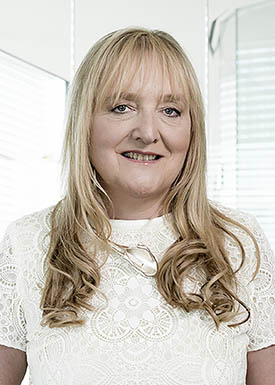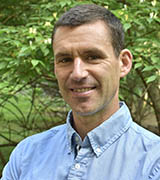Alumni News: Andrea Pfeifer
Bringing Precision Medicine to Neuroscience
Profile: Andrea Pfeifer
One of Andrea Pfeifer’s mottos comes from Carl Zuckmayer, a German writer who said, “One-half of life is luck; the other half is discipline–and that’s the important half, because without discipline you wouldn’t know what to do with your luck.” In a career that arcs from the lab to corporate leadership and back again, Pfeifer knows a bit about what it takes to write your own success story.

CREDIT: AC IMMUNE
Andrea Pfeifer, who trained at NIH, is now chief executive officer of AC Immune SA, a Swiss biopharmaceutical company that she helped launch in 2003.
The 1980s saw the dawn of precision medicine in oncology. At the National Cancer Institute (NCI), Curt Harris’s Laboratory of Human Carcinogenesis was at the forefront of molecular epidemiology. They were pioneering novel approaches to understand what factors make human cells mutate into cancer cells. Walking the halls of building 37, you would find Nobel laureate Michael Bishop, whose groundbreaking discovery of oncogenes had already changed the course of cancer research, or Lasker Award winner Robert Gallo, whose work associated retroviruses with certain leukemias and lymphomas. The idea that cancer was a multifaceted disease deserving of targeted interventions was gaining traction. Meanwhile, over in Germany at the University of Würzburg (Würzburg, Germany), a bright young scientist was considering where to start her career.
As luck would have it, two of Harris’s respected colleagues at the university had been mentoring Andrea Pfeifer to a Ph.D. in toxicology and cancer research: Professor Hans Günter Neumann (1933–2019), the chair of the university’s Institute of Toxicology and Pharmacology and a pioneer in the field of chemical carcinogenesis; and Professor Dietrich Henschler (1924–2014), an expert in pharmacology and toxicology. They encouraged Pfeifer to explore a postdoctoral experience at NIH.
Up to that point, Pfeifer’s studies were founded on a chemically based model of treating chronic diseases. She had a different vision however, and her career trajectory began to tilt toward a more precise molecular approach. “I wanted to link oncology with molecular biology and this is why I choose Curt’s lab,” said Pfeifer. In 1984 she secured a grant and a fellowship, and she joined the NIH family as a postdoctoral fellow.
Growing up in Germany, Pfeifer was exposed to the more technical aspects of life: “I changed tires, adjusted valves, and ran cars with my brothers.” She also had an uncle at the University of Würzburg, Professor Otto Volk, a physicist who stimulated and supported her curiosity in science.
At age 11, things changed for Pfeifer when her father was diagnosed with lymphoma, which ultimately pushed her toward the medical sciences. “It made me resilient, a survivor, made me a leader simply because early on in life I had to take on greater responsibility,” she recalled. Studying pharmacology and toxicology led to working on what mattered most to her—coming up with ways to diagnose and treat incurable diseases.
She remembers her time at NIH fondly. “We worked like crazy, days and nights, for this unique opportunity to generate papers, feeling like there were no limits,” she explained. “You could go out into the corridor and discuss your project with a Nobel Prize–winning scientist such as Michael Bishop. It was an incredible experience, the openness and sharing. I’ve never seen anything like that again.”
While at Harris’s lab, Pfeifer helped create the first immortalized human cell lines used as models for studying lung and liver cancer. These intentionally mutated cells divide indefinitely and are still in use today and are licensed for applications ranging from medical research to drug testing. Pfeifer would later go on to work for the food and beverage company Nestlé. In 1990 she set up a Cooperative Research and Development Agreement with NIH to further develop those cells for use in food-safety testing.
“She was very creative, rigorous with her scientific method, and had this inventive spark,” recalled Harris, who became Pfeifer’s scientific mentor and close friend. He joked, “She was also very communicative and an instigator of parties.”
Harris’s lab celebrated its 25th anniversary in 2006, long after Pfeifer had left NIH. But she helped to organize the event, bringing in alumni from across the globe. She recalled, “We decided to gift Curt a painting by Swiss artist and physician-scientist Peter Cerutti for the party.” (Before pursing an art career, Cerutti was internationally recognized for his work in cancer research and aging.) “The painting was bigger than any airline would allow and I had to persuade a German government delegation to help me bring it from Switzerland to NIH.”
In 1989 Pfeifer left NIH having published 26 papers (she now has over 200). She returned to Europe to be with her ailing father and joined Nestlé at their Research Center in Lausanne, Switzerland, rising rapidly to become head of Nestlé Global Research as she brought her knowledge of molecular diagnostics to the food industry. Over the next 13 years she would transform the company’s research direction from chemistry to biology. Pfeifer’s team sequenced the genome of the bifidus bacterium, resulting in the first probiotic yogurt. “We introduced the microbiome and linked genes to nutrition for human benefit,” she said. “We discovered how food can influence genetics, from skin health to allergy prevention–all going in the direction of precision nutrition.”
She was translating science into business. Using her multinational network Pfeifer expanded Nestlé’s research collaborations with universities around the world. She cofounded a venture capital fund to bring new projects into the company, exposing her to the world of start-up financing. It was around this time where she met the men who would be the cofounders of her future company: Nobel laureate Jean-Marie Lehn, Claude Nicolau, Fred Van Leuven, and the late NIH scientist and Lasker Award winner, Roscoe Brady (National Institute of Neurological Disorders and Stroke).
The four scientists approached Pfeifer with a potential game-changer in the world of neuroscience. “They introduced a technology that has the capability to target plaques and tangles in the brain caused by misfolding proteins,” she explained. The researchers were mainly studying prions, proteins that can trigger neighboring proteins to misfold abnormally. A hallmark of several neurodegenerative diseases, mutated proteins can spread in a virus-like manner throughout the brain and are linked to cognitive decline.
While prion diseases (such as Creutzfeldt-Jakob disease) are rare, the scientists recognized the same mechanism of action in Alzheimer disease (AD) involving amyloid-beta and tau proteins. Nearly 50 million people suffer from dementia worldwide, and AD is the leading cause. Without an effective treatment, Pfeifer saw a huge unmet need and an opportunity to improve millions of lives. In January 2003 she left Nestlé and returned to her roots in medical research.

CREDIT: AC IMMUNE
Lab at AC Immune (Lausanne, Switzerland), a company with diagnostic and therapeutic product candidates to diagnose and treat neurodegenerative diseases.
Pfeiffer and her cofounders launched AC Immune, a Swiss biopharmaceutical company, in 2003. They now have three diagnostic and nine therapeutic product candidates to diagnose and treat neurodegenerative diseases. With a focus on early detection and accurate diagnosis, the company leads the industry with their tau protein programs. Brain-imaging techniques, such as positron emission tomography (PET) scans, can detect abnormal tau concentrations decades before AD symptoms start. For example, a PET tracer (a radioactive drug used for diagnostic purposes) can identify abnormal tau which could then be treated with an appropriate vaccine, small molecule, or antibody. AC Immune’s diverse pipeline continues to evolve through ongoing clinical trials.
Much like targeting specific oncogenes, the door is now open to identify neurodegenerative diseases before they start. Pfeifer is reminded of her days at NCI. “We are at a crossroads because we can finally apply a precision approach in neuroscience as we did 30 years ago in oncology,” she said. “We can look into the brain, identify the underlying pathology, and then actually treat [neurodegenerative diseases] according to that pathology.”
In an NIH-funded study on healthy individuals, AC Immune is testing whether the drug crenezumab can prevent the onset of AD in a high-risk population in the Aburrá Valley of Columbia who are genetically predisposed to AD, show symptoms early, and often die before age 40. If the treatment works, it would be the first to show how AD might be prevented.
Pfeifer will tell you that she never wanted to be a role model. But with time, she realized that the success story around her career became an inspiration to other women. Woman are vastly underrepresented in the biopharmaceutical industry, yet Pfeifer excelled. Her secret? She credits remaining authentic, having honest mentors, and never compromising the quality of her science. Staying true to herself has been a source of strength. “I worked extremely hard, and maintained my [traditionally] feminine qualities, like working with people and bringing people together,” she said. AC Immune is currently 52% women, well above the biopharma industry average.
From scientist, to businesswomen and entrepreneur, Pfeifer has had a truly remarkable journey. “It really goes back to NIH,” she said. “I was exposed to multicultural approaches where many friendships and collaborations were formed that still exist. They are still a source of inspiration today.”
Andrea Pfeifer, Ph.D.
Chief Executive Officer of AC Immune SA, Lausanne, Switzerland
Education: University of Würzburg, Germany (Ph.D. in toxicology, cancer research)
At NIH: Postdoctoral fellowship in molecular carcinogenesis, in Curtis Harris’s Laboratory of Molecular Carcinogenesis, Center for Cancer Research, National Cancer Institute (1984–1989)
At Nestlé: Head of Global Research (1998–2002)
Notable Recognition: Recognized by FierceBiotech as one of the top 10 women in biotech (2012)
Mentors: Curtis Harris, scientific mentor; Henri B. Meier (former chairman of HBM Partners, a health-care investment company, in Basel, Switzerland), mentor in venture capital and financing; Detlev Riesner (prion and AD researcher; cofounder of Qiagen, the largest biotech company in Germany), model for entrepreneurship in science
Outside of Work: Andrea Pfeiffer lives in Lausanne, Switzerland, with her husband, John Darbyshire. She does have (some) free time and enjoys swimming and skiing. She also added, enthusiastically: “I like fashion, shoes are definitely a weak point! I like cats a lot, and I like good food. I’m actually quite a good cook.”

Michael Tabasko is an orthopedic physical therapist and writer, having lived in California and Colorado before coming to Bethesda. In his spare time, he is a competitive cyclist and enjoys adventures with his family in the mountains.
This page was last updated on Monday, March 21, 2022
